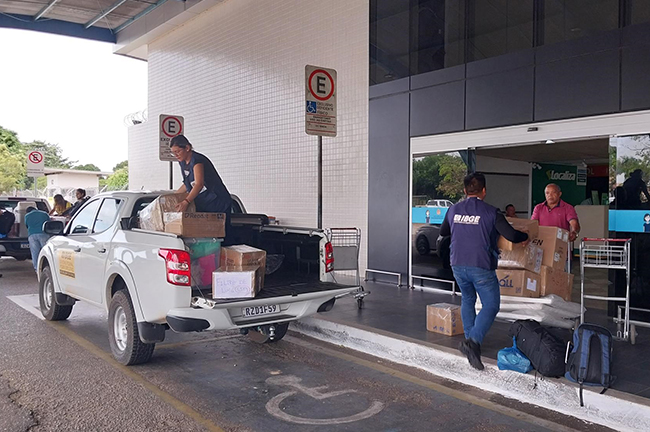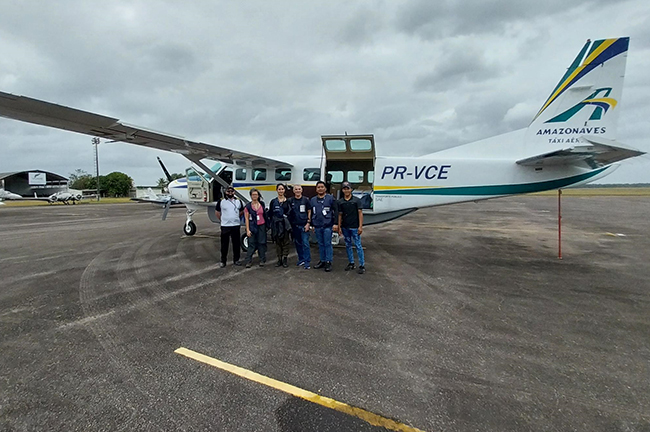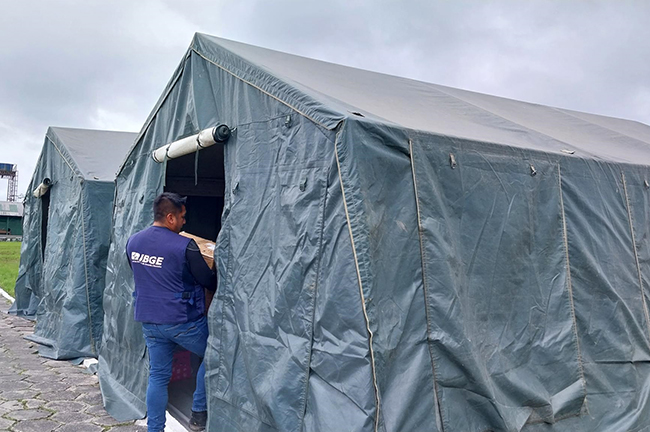2022 Census
IBGE starts last stage of aerial operation for enumeration in Yanomami Indigenous Land
March 06, 2023 09h00 AM | Last Updated: March 09, 2023 06h27 PM

This Monday (March 6th) the IBGE starts a specific data collection operation to complete the Population Census in the Yanomami Indigenous Land (TI). The formatting of the action was articulated by the Minister of Planning and Budget (MPO), Simone Tebet, together with the ministries of Health, Defense, Justice and Public Security, Indigenous Peoples and the Civil House, in addition to the General Staff of the Armed Forces. Scheduled to last 30 days, the census operation will visit 169 villages in Roraima and three in Amazonas.
In a context of official, federal, institutional and unconditional support to the Census, Minister Simone Tebet reinforced her most absolute trust in the IBGE’s work. “Few institutes in the world have the capacity and efficiency of the IBGE. That is due to the valuable work of its servants who, even earning less than they would like, literally put on their vest, knocking from door to door, to X-ray the Brazil we are”, she said. Ms. Tebet also highlighted the symbolism of completing the 2022 census collection with a native people. “The IBGE will count how many Yanomanis we are. Yes, because historically that is the people we are. How beautiful it is being able to say that the Brazilian Census will finish where it all started, with the Indigenous Peoples, with the Yanomami people”, said Ms. Tebet.
Read more: Cooperation agreement to complete Census in Yanomami lands

 More than 100 civil servants are working to carry out the Census action at the Yanomami Indigenous Land - Photo: IBGE collection
More than 100 civil servants are working to carry out the Census action at the Yanomami Indigenous Land - Photo: IBGE collection More than 100 civil servants are working to carry out the Census action at the Yanomami Indigenous Land - Photo: IBGE collection
More than 100 civil servants are working to carry out the Census action at the Yanomami Indigenous Land - Photo: IBGE collection More than 100 civil servants are working to carry out the Census action at the Yanomami Indigenous Land - Photo: IBGE collection
More than 100 civil servants are working to carry out the Census action at the Yanomami Indigenous Land - Photo: IBGE collection More than 100 civil servants are working to carry out the Census action at the Yanomami Indigenous Land - Photo: IBGE collection
More than 100 civil servants are working to carry out the Census action at the Yanomami Indigenous Land - Photo: IBGE collection More than 100 civil servants are working to carry out the Census action at the Yanomami Indigenous Land - Photo: IBGE collection
More than 100 civil servants are working to carry out the Census action at the Yanomami Indigenous Land - Photo: IBGE collection More than 100 civil servants are working to carry out the Census action at the Yanomami Indigenous Land - Photo: IBGE collection
More than 100 civil servants are working to carry out the Census action at the Yanomami Indigenous Land - Photo: IBGE collection More than 100 civil servants are working to carry out the Census action at the Yanomami Indigenous Land - Photo: IBGE collection
More than 100 civil servants are working to carry out the Census action at the Yanomami Indigenous Land - Photo: IBGE collectionThe specialized IBGE team on indigenous land collection will count on the support of technicians, military and police forces, as well as helicopters lent by the Federal Highway Police (PRF). There will be 17 teams made of IBGE enumerators, guides indicated by the National Foundation of Indian Peoples (FUNAI) and interpreters. In some cases, agents of the Special Secretariat for Indigenous Health might integrate the teams as well.
According to the IBGE Acting President and Director of Surveys, Cimar Azeredo, the MPO support together with the ministerial front play a fundamental role in the completion of the Census in Yanomami lands. He pointed out that he expects the number of Yanomamis to be much higher than the figure reached in the 2010 Census. “We expect to surpass that number by far”, he says.
Altogether, 110 civil servants are working in the conduction of the population census in the Yanomami IL, obeying the sanitation protocols established by the Ministry of health and pursuant to the 706 ADPF (Action for Breach of Fundamental Precept) terms of the federal Supreme Court, which provides for the sanitary barrier in the area.
The IBGE has already carried out 50% of the collection in the territory. The operation with the aerial support aims at completing the last half of the enumeration of the region, more specifically, of the Indigenous people living in hard-to-reach areas, only accessible by helicopters. “The main difficulty id the complex logistic of access to the villages, which involves different means of transportation – by land, river and air by small-sized airplanes and helicopters – bedsides paths in trails between neighboring villages across the Amazon forest”, explains the coordinator of the Census of Traditional Peoples and Communities, Martha Antunes. “This logistic demands flexibility on the part of enumerators and resilience to adapt to the different transportation to reach the villages and to stay in the communities for long periods of time”, she adds.
The necessary articulation between the several ministries and the IBGE demonstrates the complexity of the collection in the Yanomami Indigenous Land”, observes the state superintendent of the IBGE in the Amazonas, José Ilclesson. “The joint effort, involving IBGE teams from Amazonas and Roraima, will allow for the consolidation of a fundamental aspect in the population census: being able to enumerate all citizens, regardless their localization in the territory and, therefore, for the fulfilment of the mission of producing and providing information for the effective exercise of citizenship.
Census Logistic in Yanomami Indigenous Land
The work groups are transported in small aircraft provided by Funai to the town of Surucucu, in Alto Alegre (RR), where the 4th Special Border Platoon of the Brazilian Army and an Indigenous Health Base are located. From there, they take a helicopter to reach the communities.
The Army will provide support with accommodation in Surucucu and transporting aviation fuel for the helicopters, and FAB will support transporting supplies and food from field missions to the location of Surucucu. The health centers in the locality will serve as support bases for the IBGE enumerators during the operation.
For the IBGE manager of Traditional Territories and Protected Areas, Fernando Damasco, completing the Census will be the best way to accurately identify the population of the Yanomami IL, of recent contact, and their demographic characteristics. “The data will also reveal how often health teams go to the community, the existence of indigenous health and sanitation agents, information on communication infrastructure, access to electricity, sanitation and documentation”, he says.
"After two years of meticulous planning and intense work involving all kinds of preparations, from selection and training to the purchase of all the basic items for survival and food, finally our teams can go into the field to enumerate the Yanomamis", celebrates the state superintendent of the IBGE in Roraima, Roberto Kuerten.
With collection closed in February, census started data processing phase
Last Tuesday (Feb 28), the IBGE ended the coverage of household collection of the Population Census. Altogether, 189,261,144 persons were registered (91%), compared to the population estimate released on December 28, 2022. On March 1, the Institute began the Data Processing Phase, which comprises the work of Analysis of Census Data, to be carried out by the Census Closing Committee (CFC). These tasks imply some field visits, that is, some households will still be visited by enumerators or supervisors. The release of the first results of the Population Census is scheduled for the end of April.
Read more: IBGE concludes Census data collection, begins calculation phase




















